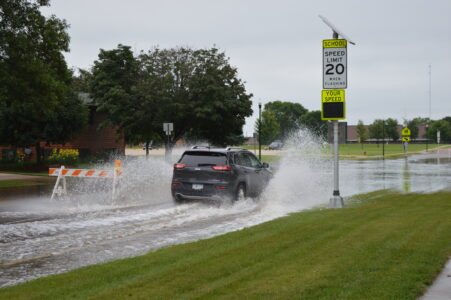Enjoys helping ESL students
Roshawn Galle — Lynd School

Lynd School District English as a Second Language teacher Roshawn Galle works with students of all ages. She has been Lynd’s ESL specialist for 14 years.
Roshawn Galle specializes in helping students overcome language barriers, which in turn helps them to reach their academic and social potential.
She serves as the English as a Second Langauge teacher for pre-K through eighth grade students in the Lynd School District. Her days are filled with assisting students of all age groups.
“It’s different being an ESL teacher in a small district because of the range of students I teach,” Galle said. “I like the variety. I get to sing and dance with the young children, and I have great conversations with the older ones.”
She began to specialize in ESL instruction 14 years ago after teaching in Lynd with a home economics background. At the time, Lynd had a need for a licensed ESL teacher and had difficulty finding one during a region-wide shortage.
Her decision was influenced by how she grew up in Minneapolis and met people from many different cultures through her mother’s work at the University of Minnesota.
“I’ve always felt that having people from a variety of cultures enriches our communities,” Galle said. “I wanted to be part of bringing that perspective to our school. I felt I could advocate for non-Enligh speaking students and serve as a good instructor for them.”
She said her classes encompass both reading comprehension and lessons that relate to all major school subjects. She frequently collaborates with other teachers to enhance what students learn in classes other than ESL.
Students with limited English skills usually receive ESL instruction for at least several years. Research shows that it takes three to five years of ESL reinforcement for students to become fluent in all social situations. About five to seven years is needed to have full profiency with using English in academic learning.
She noted that much of the need for instruction shows up in proficiency tests, which identify particular grammar and usage abilities that students need to acquire.
“We’ll often have students who seem proficient because they can sustain a conversation,” she said. “There’s more to it than that. It takes time and effort before they can use English at their grade level.”
About 15 percent of all Lynd students speak a language other than English at home. Galle’s students are all native Spanish speakers, who account for 70 percent of all ESL learners in the United States.
She pointed to statistics that show how most ESL students were born in the United States. The total stands at about 82 percent for all of the young ESL learners. For teenagers, the percentage is about 65 percent.
One of the most important success factors with ESL learning is the age at which a student starts the process. Being part of an ESL class while in pre-school gives students a valuable foundation for long-term success as bilingual learners.
“Young children show no fear when it comes to trying to use English,” Galle said. “They’ll try and they’ll improve faster by using it. Teenagers with limited English skills are often reluctant to use English around their peers unless it’s necessary.”
She said ESL students of all ages almost always demonstrate a strong desire to attain higher levels of success when it comes to English profiency.
“They’re very motivated,” she said. “Part of what keeps them interested is the way English is useful from a social standpoint. It makes them better able to fit in with other students and more able to form friendships with a wide range of classmates.”
She said part of every ESL class is devoted to conversation practice, in which students can talk about a wide range of subjects with their instructor and with each other.
Research shows that ability with a native language is helpful to mastering English. Parents and other older role models help by encouraging conversation at home in both languages.
Classroom teachers at all grade levels have also played a stronger role as language mentors in recent years. A teaching license in Minnesota now requires training in the ESL learning process.
As an ESL teacher serving a full range of grades, Galle often sees progress with English coincide with other academic success. She has one former student who is currently studying to become as ESL instructor.
“I like to watch my students grow,” she said. “It’s often amazing how much progress they make from one year to the next. I look forward to coming to work every day.”
Lynd Principal Jason Swenson said Galle brings many good qualities to her role as the district’s ESL specialist, which leads to consistently good student achievement.
“Roshawn plays an important role at our school,” Swenson said. “She brings a lot of enthusiasm to her ESL instruction. She’s great with the students, and also does a really good job of communicating with other teachers and the families.”



